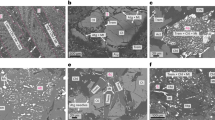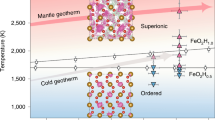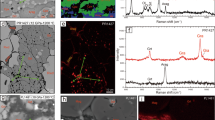Abstract
Hydrogen is commonly produced during the high-temperature hydration of mafic and ultramafic rocks, owing to the oxidation of reduced iron present in the minerals. Hydrothermal hydrogen is known to sustain microbial communities in submarine vent and terrestrial hot-spring systems. However, the rates and mechanisms of hydrogen generation below temperatures of 150 °C are poorly constrained. As such, the existence and extent of hydrogen-fuelled ecosystems in subsurface terrestrial and oceanic aquifers has remained uncertain. Here, we report results from laboratory experiments in which we reacted ground ultramafic and mafic rocks and minerals—specifically peridotite, pyroxene, olivine and magnetite—with anoxic fluids at 55 and 100 °C, and monitored hydrogen gas production. We used synchrotron-based micro-X-ray fluorescence and X-ray absorption near-edge structure spectroscopy to identify changes in the speciation of iron in the materials. We report a strong correlation between molecular hydrogen generation and the presence of spinel phases—oxide minerals with the general formula [M2+M23+]O4 and a cubic crystal structure—in the reactants. We also identify Fe(III)-(hydr)oxide reaction products localized on the surface of the spinel phases, indicative of iron oxidation. We propose that the transfer of electrons between Fe(II) and water adsorbed to the spinel surfaces promotes molecular hydrogen generation at low temperatures. We suggest that these localized sites of hydrogen generation in ultramafic aquifers in the oceanic and terrestrial crust could support hydrogen-based microbial life.
This is a preview of subscription content, access via your institution
Access options
Subscribe to this journal
Receive 12 print issues and online access
$259.00 per year
only $21.58 per issue
Buy this article
- Purchase on Springer Link
- Instant access to full article PDF
Prices may be subject to local taxes which are calculated during checkout




Similar content being viewed by others
References
Schrenk, M. O., Kelley, D. S., Bolton, S. A. & Baross, J. A. Low archaeal diversity linked to subseafloor geochemical processes at the Lost City Hydrothermal Field, Mid-Atlantic Ridge. Environ. Microbiol. 6, 1086–1095 (2004).
Kelley, D. S. et al. A serpentinite-hosted ecosystem: The lost city hydrothermal field. Science 307, 1428–1434 (2005).
Charlou, J. L., Donval, J. P., Fouquet, Y., Jean-Baptiste, P. & Holm, N. Geochemistry of high H-2 and CH4 vent fluids issuing from ultramafic rocks at the Rainbow hydrothermal field (36 degrees 14’N, MAR). Chem. Geol. 191, 345–359 (2002).
Flores, G. E. et al. Microbial community structure of hydrothermal deposits from geochemically different vent fields along the Mid-Atlantic Ridge. Environ. Microbiol. 13, 2158–2171 (2011).
Moody, J. B. Serpentinization: A review. Lithos 9, 125–138 (1976).
Seyfried, W. E., Foustoukos, D. I. & Fu, Q. Redox evolution and mass transfer during serpentinization: An experimental and theoretical study at 200 °C, 500 bar with implications for ultramafic-hosted hydrothermal systems at Mid-Ocean Ridges. Geochim. Cosmochim. Acta 71, 3872–3886 (2007).
McCollom, T. M. & Bach, W. Thermodynamic constraints on hydrogen generation during serpentinization of ultramafic rocks. Geochim. Cosmochim. Acta 73, 856–875 (2009).
Klein, F. et al. Iron partitioning and hydrogen generation during serpentinization of abyssal peridotites from 15 N on the Mid-Atlantic Ridge. Geochim. Cosmochim. Acta 73, 6868–6893 (2009).
Jones, L. C., Rosenbauer, R., Goldsmith, J. I. & Oze, C. Carbonate control of H2 and CH4 production in serpentinization systems at elevated P-Ts. Geophys. Res. Lett. 37, L14306 (2010).
Malvoisin, B., Brunet, F., Carlut, J., Roumejon, S. & Cannat, M. Serpentinization of oceanic peridotites: 2. Kinetics and processes of San Carlos olivine hydrothermal alteration. J. Geophys. Res. 117, B04102 (2012).
Takai, K. et al. Cell proliferation at 122 °C and isotopically heavy CH4 production by a hyperthermophilic methanogen under high-pressure cultivation. Proc. Natl Acad. Sci. USA 105, 10949–10954 (2008).
Barnes, I. & O’Neil, J. R. The relationship between fluids in some fresh alpine-type ultramafics and possible modern serpentinization, western United States. Geol, Soc. Amer. Bull. 80, 1947–1960 (1969).
Proskurowski, G., Lilley, M. D., Kelley, D. S. & Olson, E. J. Low temperature volatile production at the Lost City Hydrothermal Field, evidence from a hydrogen stable isotope geothermometer. Chem. Geol. 229, 331–343 (2006).
Barnes, I., O’Neil, J. R. & Trescases, J-J. Present day serpentinization in New Caledonia, Oman and Yugoslavia. Geochim. Cosmochim. Acta 42, 144–145 (1978).
Hoehler, T. M. Biological energy requirements as quantitative boundary conditions for life in the subsurface. Geobiology 2, 205–215 (2004).
Nealson, K. H., Inagaki, F. & Takai, K. Hydrogen-driven subsurface lithoautotrophic microbial ecosystems (SLiMEs): do they exist and why should we care? Trends Microbiol. 13, 405–410 (2005).
Evans, B. W., Kuehner, S. M. & Chopelas, A. Magnetite-free, yellow lizardite serpentinization of olivine websterite, Canyon Mountain complex, NE Oregon. Am. Miner. 94, 1731–1734 (2009).
Stevens, T. O. & McKinley, J. P. Abiotic controls on H-2 production from basalt-water reactions and implications for aquifer biogeochemistry. Environ. Sci. Technol. 34, 826–831 (2000).
Neubeck, A., Duc, N. T., Bastviken, D., Crill, P. & Holm, N. G. Formation of H2 and CH4 by weathering of olivine at temperatures between 30 and 70 °C. Geochem. Trans. 12, 6 (2011).
Parkes, R. J. et al. Prokaryotes stimulate mineral H2 formation for the deep biosphere and subsequent thermogenic activity. Geology 39, 219–222 (2011).
Olsson, J. et al. Olivine reactivity with CO2 and H2O on a microscale: Implications for carbon sequestration. Geochim. Cosmochim. Acta 77, 86–97 (2012).
Mancey, D., Shoesmith, D., Lipkowski, J., McBride, A. & Noel, J. An electrochemical investigation of the dissolution of magnetite in acidic electrolytes. J. Electrochem. Soc. 140, 637–642 (1993).
Parkinson, G. S., Novotny, Z., Jacobson, P., Schmid, M. & Diebold, U. Room temperature water splitting at the surface of magnetite RID A-3681-2010. J. Am. Chem. Soc. 133, 12650–12655 (2011).
Hamilton, W. Neutron diffraction investigation of the 119K Transition in Magnetite. Phys. Rev. 110, 1050–1057 (1958).
Balko, B. & Hoy, G. Selective excitation double Mossbauer studies (SEDM) of electron hopping. Physica B C 86, 953–954 (1977).
Skomurski, F. N., Kerisit, S. & Rosso, K. M. Structure, charge distribution, and electron hopping dynamics in magnetite (Fe3O4) (100) surfaces from first principles. Geochim. Cosmochim. Acta 74, 4234–4248 (2010).
Peterson, M., Brown, G., Parks, G. & Stein, C. Differential redox and sorption of Cr(III/VI) on natural silicate and oxide minerals: EXAFS and XANES results. Geochim. Cosmochim. Acta 61, 3399–3412 (1997).
White, A. & Peterson, M. Reduction of aqueous transition metal species on the surfaces of Fe(II)-containing oxides. Geochim. Cosmochim. Acta 60, 3799–3814 (1996).
Shipley, H. J., Yean, S., Kan, A. T. & Tomson, M. B. Adsorption of arsenic to magnetite nanoparticles: Effect of particle concentration, pH, ionic strength, and temperature. Environ. Toxicol. Chem. 28, 509–515 (2009).
Foustoukos, D. & Seyfried, W. Hydrocarbons in hydrothermal vent fluids: The role of chromium-bearing catalysts. Science 304, 1002–1005 (2004).
Fu, Q., Lollar, B. S., Horita, J., Lacrampe-Couloume, G. & Seyfried, W. E. Abiotic formation of hydrocarbons under hydrothermal conditions: Constraints from chemical and isotope data. Geochim. Cosmochim. Acta 71, 1982–1998 (2007).
Joseph, Y., Kuhrs, C., Ranke, W. & Weiss, W. Adsorption of water on Fe3O4(111) studied by photoelectron and thermal desorption spectroscopy. Surf. Sci. 433, 114–118 (1999).
Kendelewicz, T. et al. Reaction of water with the (100) and (111) surfaces of Fe3O4 . Surf. Sci. 453, 32–46 (2000).
Petitto, S. C., Tanwar, K. S., Ghose, S. K., Eng, P. J. & Trainor, T. P. Surface structure of magnetite (111) under hydrated conditions by crystal truncation rod diffraction. Surf. Sci. 604, 1082–1093 (2010).
Williams, A. & Scherer, M. Spectroscopic evidence for Fe(II)–Fe(III) electron transfer at the iron oxide-water interface. Environ. Sci. Technol. 38, 4782–4790 (2004).
Silvester, E. et al. Redox potential measurements and Mossbauer spectrometry of Fe-II adsorbed onto Fe-III (oxyhydr)oxides RID A-1353-2010. Geochim. Cosmochim. Acta 69, 4801–4815 (2005).
Tanwar, K. S., Petitto, S. C., Ghose, S. K., Eng, P. J. & Trainor, T. P. Structural study of Fe(II) adsorption on hematite(1(1)over-bar02). Geochim. Cosmochim. Acta 72, 3311–3325 (2008).
Rosso, K. M., Yanina, S. V., Gorski, C. A., Larese-Casanova, P. & Scherer, M. M. Connecting observations of hematite (alpha-Fe(2)O(3)) growth catalyzed by Fe(II). Environ. Sci. Technol. 44, 61–67 (2010).
Catalano, J. G., Fenter, P., Park, C., Zhang, Z. & Rosso, K. M. Structure and oxidation state of hematite surfaces reacted with aqueous Fe(II) at acidic and neutral pH RID A-8544-2008. Geochim. Cosmochim. Acta 74, 1498–1512 (2010).
Mckibben, M. & Barnes, H. Oxidation of pyrite in low-temperature acidic solutions—Rate laws and surface textures. Geochim. Cosmochim. Acta 50, 1509–1520 (1986).
White, A., Peterson, M. & Hochella, M. Electrochemistry and dissolution kinetics of magnetite and ilmenite. Geochim. Cosmochim. Acta 58, 1859–1875 (1994).
Bearat, H. et al. Carbon sequestration via aqueous olivine mineral carbonation: Role of passivating layer formation. Environ. Sci. Technol. 40, 4802–4808 (2006).
Schott, J., Pokrovsky, O. S. & Oelkers, E. H. in Thermodynamics and Kinetics of Water–Rock Interaction Vol. 70 (eds Oelkers, E. & Schott, J.) 207–258 (Mineralogical Soc. Amer., 2009).
White, A. & Yee, A. Aqueous oxidation–reduction kinetics associated with coupled electron cation transfer from iron-containing silicates at 25 °C. Geochim. Cosmochim. Acta 49, 1263–1275 (1985).
Menez, B., Pasini, V. & Brunelli, D. Life in the hydrated suboceanic mantle. Nature Geosci. 5, 133–137 (2012).
Ehlmann, B. L., Mustard, J. F. & Murchie, S. L. Geologic setting of serpentine deposits on Mars. Geophys. Res. Lett. 37, L06201 (2010).
Hoal, K. O. et al. Research in quantitative mineralogy: Examples from diverse applications. Miner. Eng. 22, 402–408 (2009).
Mayhew, L. E., Webb, S. M. & Templeton, A. S. Microscale imaging and identification of Fe speciation and distribution during fluid–mineral reactions under highly reducing conditions. Environ. Sci. Technol. 45, 4468–4474 (2011).
Webb, S. M. The MicroAnalysis Toolkit: X-ray fluorescence image processing software. AIP Conf. Proc. 1365, 196–199 (2011).
Webb, S. M. SIXPack: A graphical user interface for XAS analysis using IFEFFIT. Phys. Scr. 2005, 1011–1014 (2005).
Acknowledgements
G. Lau and E. Swanner participated in collection of reference spectra. We thank the Smithsonian National Museum of Natural History for minerals used as Fe model compounds. We acknowledge F. Luiszer, J. Drexler and P. Boni, at the University of Colorado-Boulder, for IC-OES, ICP-MS and electron microprobe analyses, and sample preparation work, respectively. We thank F. Majs (U. Alaska) for conducting XRD analyses. This work was directly supported by the David and Lucille Packard Foundation (A.S.T.) and a DOE Early Career grant (A.S.T.) (DE-SC0006886). Synchrotron analyses were conducted on beamlines 2-3, 11-2, and 4-1 at the Stanford Synchrotron Radiation Lightsource (SSRL), a national user facility operated by Stanford University on behalf of the Department of Energy, Office of Basic Energy Sciences, through the Structural Molecular Biology Program, supported by DOE Office of Biological and Environmental Research and the National Institutes of Health.
Author information
Authors and Affiliations
Contributions
L.E.M. and A.S.T. conceived of and designed the experiments. L.E.M. and E.T.E. assembled the experiments, conducted gas chromatography analyses, and sampled for aqueous, synchrotron and XRD analyses. L.E.M. and A.S.T. conducted synchrotron-based X-ray spectroscopy and microprobe mapping data collection. L.E.M. processed and analysed all data. L.E.M completed the data interpretation and wrote the manuscript with input and critical discussion from A.S.T., E.T.E., T.P.T. and T.M.M.
Corresponding author
Ethics declarations
Competing interests
The authors declare no competing financial interests.
Supplementary information
Supplementary Information
Supplementary Information (PDF 2123 kb)
Rights and permissions
About this article
Cite this article
Mayhew, L., Ellison, E., McCollom, T. et al. Hydrogen generation from low-temperature water–rock reactions. Nature Geosci 6, 478–484 (2013). https://doi.org/10.1038/ngeo1825
Received:
Accepted:
Published:
Issue Date:
DOI: https://doi.org/10.1038/ngeo1825
This article is cited by
-
Chemolithotrophic biosynthesis of organic carbon associated with volcanic ash in the Mariana Trough, Pacific Ocean
Communications Earth & Environment (2023)
-
Electron transfer rules of minerals under pressure informed by machine learning
Nature Communications (2023)
-
Geological evidence for high H2 production from komatiites in the Archaean
Nature Geoscience (2023)
-
Podiform magnetite ore(s) in the Sabzevar ophiolite (NE Iran): oceanic hydrothermal alteration of a chromite deposit
Contributions to Mineralogy and Petrology (2021)
-
Energy-converting hydrogenases: the link between H2 metabolism and energy conservation
Cellular and Molecular Life Sciences (2020)



